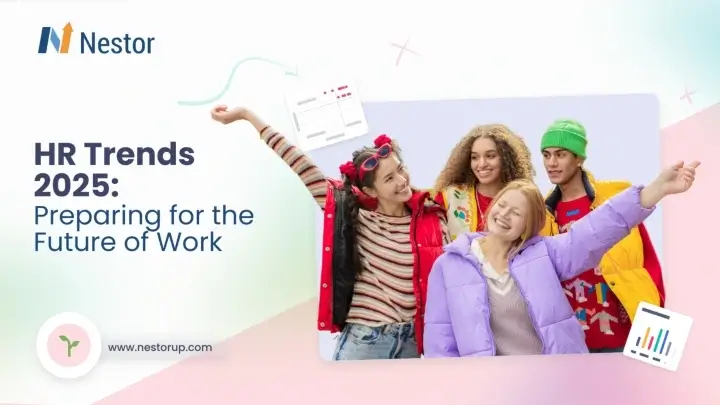
Contents
Hiring never stops. Companies constantly search for the right people to fill critical roles, yet the answer is often right in front of them. Instead of looking outside, businesses could be tapping into the talent they already have, with internal recruiting.
Internal recruiting—promoting, transferring, or reassigning employees—offers a faster, cost-effective, and more reliable way to fill positions. It rewards top performers, boosts morale, and strengthens company culture. But despite these advantages, many organizations still default to external hiring, overlooking employees who are ready to grow.
According to LinkedIn Learning’s 2024 Workplace Learning Report, only 33% of organizations offer formal internal mobility programs, and a mere one-fifth of employees feel confident about making internal moves.
What’s the impact? Higher turnover, longer hiring timelines, and increased costs. Employees leave because they don’t see a future within the company, while HR teams struggle to find and onboard new hires. It’s an expensive cycle that could be avoided with a strong internal recruitment strategy.
So why aren’t more companies prioritizing internal hiring? Some fear a limited talent pool. Others worry about internal competition. And many simply don’t have a structured approach to make it work.
The truth is, internal recruiting is one of the most powerful tools for building a strong, motivated workforce. It’s time to rethink how companies approach hiring and recognize the benefits of looking inward first.
Let’s explore the key advantages of internal recruiting and why it should be a priority for every HR team.
What is internal recruiting?
Internal recruiting (or internal recruitment) is the process of filling job openings with employees who already work for the company. Instead of searching for external candidates, businesses identify and promote talent from within. This can mean moving employees into higher positions, shifting them to different roles, or encouraging internal referrals.
This approach benefits both employees and employers. Employees see a clear career path, which increases engagement and job satisfaction. Employers, on the other hand, save time and money by hiring people who already understand the company’s culture, processes, and expectations.
Common Methods of Internal Recruiting
Companies use several strategies to recruit from within:
- Promotions: Advancing employees to roles with greater responsibilities, higher pay, and leadership opportunities. Promotions reward high performance and encourage employees to stay and grow within the company.
- Lateral Moves: Reassigning employees to different roles at the same level to help them develop new skills, gain broader experience, or work in a different department. Lateral moves allow businesses to optimize talent while giving employees fresh challenges.
- Transfers: Moving employees to another team, location, or branch where their skills are needed. Transfers help maintain business continuity and prevent skill shortages in different parts of the organization.
- Employee Referrals: Encouraging employees to recommend colleagues for internal job openings. This can speed up hiring and ensure a better cultural fit, as current employees often know who would be a strong candidate for a role.
Why is internal recruiting a necessity?
Companies can no longer afford to overlook internal recruiting. Several factors are making it a key strategy for businesses that want to stay competitive while maintaining a stable workforce.
1. A Tight Talent Market
Hiring has become more challenging. With unemployment rates remaining low, companies struggle to find qualified candidates for open roles. A ManpowerGroup report highlights this issue, revealing that an unprecedented 75% of employers worldwide are having difficulty filling positions, with healthcare, IT, and logistics sectors experiencing the greatest challenges.
External hiring is not only expensive but also highly competitive, as businesses fight over the same limited talent pool. In many cases, companies spend months searching for the “perfect” external candidate when an equally capable employee is already working for them.
Internal recruiting allows companies to bypass long hiring processes and reduce reliance on external searches. Instead of competing for talent, they can develop and promote from within.
2. Growing Skill Gaps
The demand for new skills is rising faster than ever. According to Guild, 375 million people will need to reskill in the next two years alone. Many companies face talent shortages not because they lack employees but because their workforce doesn’t yet have the right skills for emerging roles.
Relying solely on external hiring to address skill gaps is costly and unsustainable. Internal recruiting, combined with strong learning and development programs, helps companies build the talent they need rather than constantly searching for it elsewhere.
Businesses that invest in upskilling and reskilling employees create a pipeline of qualified internal candidates, ensuring they can fill roles quickly without scrambling to find external hires.
3. The Challenge of Hiring Younger Generations
Hiring Gen Z employees presents unique challenges. Their expectations around career growth, flexibility, and learning opportunities differ from previous generations. They prioritize:
- Frequent promotions and career mobility
- Work-life balance and flexible work arrangements
- Strong learning and development (L&D) programs
If these needs aren’t met, they’re more likely to leave for companies that offer better career progression. Internal recruiting addresses this by creating clear paths for advancement, helping businesses attract and retain younger talent.
4. Economic Uncertainty and Cost Efficiency
Hiring externally is expensive. Job ads, recruiter fees, interviews, and onboarding costs add up quickly. In uncertain economic times, businesses are prioritizing efficiency and cost savings, making internal recruiting a more attractive option.
The financial impact of external hiring has grown significantly in recent years. According to the Society for Human Resource Management (SHRM), the average cost per hire has increased from $4,129 in 2019 to $4,700 in 2023—a 14% increase. For specialized positions in high-demand fields like cybersecurity, data science, and nursing, these costs can exceed $10,000 per hire.
Position level also dramatically affects hiring expenses. While filling an entry-level position typically costs between $2,000-$3,000, executive hiring averages $28,329, with C-suite roles commanding even higher prices due to specialized recruiting processes, extensive interviewing, and relocation expenses.
The past few years have shown how unpredictable hiring trends can be. Many companies went through massive hiring sprees, only to lay off employees months later. This cycle damages company morale and employer reputation. By focusing on internal recruitment, businesses can maximize existing resources while maintaining workforce stability.
5. Retaining Institutional Knowledge
Every time an employee leaves, they take valuable knowledge with them. Processes, client relationships, and industry insights are often lost when a company relies too heavily on external hiring. Internal recruiting helps retain institutional knowledge, ensuring that expertise stays within the company.
Promoting from within also leads to smoother transitions. Internal hires already understand the company culture and workflows, meaning they require less time to adjust. This reduces disruption and keeps projects moving forward without long onboarding periods.
77% of businesses globally reported difficulty in finding the skilled talent they needed in 2023.
— ManpowerGroup
Advantages of internal recruiting
Despite widespread recognition of its value, internal mobility remains significantly underutilized in today’s workplace. According to a Deloitte survey of nearly 10,000 business leaders across 119 countries, while 76% acknowledged internal talent mobility as essential, a mere 6% believed their organizations were effectively mobilizing employees between positions.
This striking gap between awareness and implementation highlights why understanding the concrete advantages of internal recruiting has never been more important for forward-thinking organizations.
1. Retain Top Talent and High-Potential Employees (HiPos)
Keeping exceptional performers and employees with leadership potential represents one of the most valuable benefits of internal recruiting practices.
High-potential employees (HiPos) typically seek continuous growth and new challenges. Without clear advancement opportunities, these valuable team members often look elsewhere to fulfill their career ambitions. Internal mobility programs provide the growth pathways these employees need, giving them reasons to stay and contribute their talents long-term.
Workers who have moved internally have a 64% chance of remaining with an organization after three years and are 3.5x more likely to be engaged compared to those who stay in their current jobs.
— LinkedIn
Progressive organizations identify their HiPos early and create individualized development plans. These plans include targeted training, stretch assignments, and mentoring relationships that prepare them for advancement. When positions open, these prepared HiPos become natural candidates, creating a virtuous cycle of development and opportunity.
This approach to talent management reduces the significant costs associated with turnover. When top performers leave, organizations lose not only their skills and knowledge but also their positive influence on team performance and culture. The costs of replacement hiring, training, and productivity losses during transitions can be substantial.
Companies with effective internal recruiting systems report higher retention rates among their most valuable employees. These employees develop deeper organizational loyalty when they see tangible evidence that their contributions are recognized and rewarded with new opportunities.
The visibility of internal advancement also motivates other employees to improve their performance and develop their skills. This creates a culture of continuous improvement and healthy ambition, where employees strive to qualify for future opportunities.
2. Strategic Skills Deployment and Development
Organizations that practice internal recruiting gain the ability to strategically deploy and develop skills across the company, creating a more adaptable and resilient workforce.
Internal mobility allows companies to shift talent where it’s most needed, responding quickly to changing business priorities. Employees bring their transferable skills to new contexts, often finding innovative applications that might not have been apparent in their previous roles. This cross-pollination of skills and ideas can lead to process improvements and creative solutions.
When employees move between roles, they develop broader skill sets and deeper organizational understanding. This creates versatile professionals who can contribute in multiple areas, increasing the organization’s flexibility during transitions or periods of rapid change.
Organizations can also use internal mobility to address specific skill gaps. By identifying employees with adjacent skills and providing targeted development, companies build the capabilities they need from within rather than competing for scarce talent in the external market.
This strategic approach to skills management creates a workforce that continues to develop and adapt to changing business needs, rather than becoming obsolete when market requirements shift.
3. Shortened Hiring Timeline
Time is a critical factor in the recruitment process. Vacant positions can lead to productivity gaps, increased workload for other team members, and potential project delays. Internal recruiting offers a significant advantage in this regard.
The hiring process for external candidates typically involves multiple stages: job posting, application collection, resume screening, multiple interview rounds, reference checks, offer negotiation, and notice periods. This process can take several months, depending on the position and industry.
In contrast, internal recruitment can be completed much faster. The organization already has access to employees’ performance data and work histories. Interviews can be expedited, as both parties are already familiar with each other. Once selected, internal candidates can often transition to their new roles within days or weeks, rather than months.
This quick turnaround helps maintain operational continuity and ensures that projects and responsibilities don’t languish due to staffing gaps.
4. Cultural Fit and Performance
External candidates always represent a certain risk. Despite thorough interviews and reference checks, it’s difficult to predict how well they’ll adapt to the organization’s culture and work environment.
Internal candidates eliminate much of this uncertainty. They’ve already demonstrated their ability to work within the company’s culture and adapt to its values and expectations. Their behavior, work ethic, and interpersonal skills are known quantities, reducing the risk of a poor cultural match.
Furthermore, internal candidates come with established performance records. Their strengths, weaknesses, and work patterns are documented and observable. This provides a reliable basis for predicting their success in a new role, offering greater certainty than the promises and potential of external candidates.
5. Succession Planning
Effective organizations think long-term about their leadership needs. Internal recruiting naturally supports succession planning by creating channels for employee development and advancement.
By identifying high-potential employees and moving them through various roles, companies prepare them for future leadership positions. This creates a pipeline of qualified internal candidates ready to step into key roles when needed. Such preparation ensures business continuity during transitions and reduces the risks associated with bringing in external leaders unfamiliar with the organization.
Succession planning through internal mobility also allows organizations to shape future leaders who understand the company’s operations from various perspectives. An employee who has worked in different departments or functions brings valuable cross-functional knowledge to leadership roles.
6. Boost the Company’s Status and Attractiveness as an Employer
Organizations known for promoting from within gain significant advantages in the talent marketplace. This reputation as a growth-oriented employer becomes a powerful asset.
Companies that prioritize internal mobility often develop stronger employer brands. This is particularly important as research shows 75% of job seekers research a company’s reputation before applying, and half of candidates won’t work for poorly-regarded companies even with higher pay offers.
When potential candidates see clear evidence that an organization invests in employee development and offers genuine career advancement, they’re more likely to view that company as a desirable place to work. This reputation helps attract higher-quality candidates even when external hiring is necessary.
The visible commitment to employee growth strengthens the company’s position during salary negotiations. Candidates may accept slightly lower compensation when they recognize the long-term career benefits and growth potential. This can lead to considerable cost savings in the recruitment process.
Additionally, organizations with robust internal mobility programs often receive positive reviews on employment platforms and social media. This organic positive publicity extends the company’s reach and attractiveness to passive job seekers who might not be actively searching but become interested when they hear about the positive internal culture.
Internal recruiting also demonstrates stability and organizational health. Companies that consistently develop leadership from within signal financial well-being and sustainable business practices, further enhancing their appeal to top talent in the market.
Potential Drawbacks of Internal Recruiting
While internal recruiting offers numerous benefits, it’s important to acknowledge its limitations and challenges:
Limited Candidate Pool: Depending on the size of your organization and the specialized skills required, you may have a restricted pool of suitable internal candidates. Some positions require specific expertise or certifications that your current workforce may not possess.
Internal Competition: When multiple employees compete for the same position, it can create tension and affect team dynamics. Those who aren’t selected might experience disappointment or resentment, potentially affecting their engagement and performance.
Lack of Fresh Perspectives: Relying exclusively on internal candidates can limit the influx of new ideas and approaches. External hires often bring fresh perspectives, industry best practices, and innovative thinking from their experiences with other organizations.
Skills Gaps: While internal candidates might have strong company knowledge, they may lack specific technical skills or experience needed for certain positions. This can necessitate additional training and development, potentially offsetting some of the time and cost savings.
Cascading Vacancies: When you fill a position internally, you create another vacancy that needs to be filled. This can trigger a chain reaction of positions to be filled, potentially creating multiple recruitment challenges instead of just one.
Risk of Complacency: Organizations that rely too heavily on internal recruitment might become insular and resistant to change. Without the regular infusion of external perspectives, companies risk becoming stagnant and falling behind industry trends.
Best Practices for Implementing Internal Recruitment
To maximize the benefits of internal recruiting while minimizing its drawbacks, consider these best practices:
Establish Clear Policies and Criteria
Develop formal policies that outline how internal recruitment works within your organization. These policies should address:
- Eligibility requirements (e.g., minimum time in current position before applying elsewhere)
- Application procedures
- Selection criteria
- Feedback mechanisms for unsuccessful candidates
- Transition timelines for selected candidates
Clear policies promote fairness and transparency, reducing perceptions of favoritism or arbitrary decision-making. They also help managers and employees understand how internal mobility works in practice.
The selection criteria should be objective and relevant to the position. Consider factors such as performance history, skills alignment, growth potential, and leadership capabilities. Document these criteria and apply them consistently across all candidates.
Promote Transparency in Job Postings
Make internal job opportunities visible and accessible to all eligible employees. This might involve:
- Creating an internal job board
- Sending regular communications about open positions
- Ensuring that all positions (with few strategic exceptions) are posted internally before external recruitment begins
- Providing clear, detailed job descriptions that accurately reflect the role’s responsibilities and requirements
Transparency in job postings encourages broader participation and helps employees identify roles that match their skills and career aspirations. It also demonstrates the organization’s commitment to providing internal growth opportunities.
The job descriptions should be specific about the qualifications, experience, and competencies required. This helps employees self-assess their suitability for the role and prepare targeted applications that address the key requirements.
Provide Training and Development Programs
Effective internal recruiting requires a pipeline of prepared candidates. Invest in training and development programs that help employees build the skills they’ll need for advancement. This might include:
- Technical training for specific job functions
- Leadership development programs
- Cross-functional project opportunities
- Mentoring and coaching initiatives
- Job rotation programs
These development opportunities prepare employees for future roles while demonstrating the organization’s investment in their growth. They also help address skill gaps that might otherwise limit internal mobility.
Training should be aligned with both organizational needs and individual career aspirations. Regular skills assessments and career conversations can help identify development priorities and create personalized learning plans.
Encourage Open Communication Between Departments
Break down silos between departments to facilitate internal mobility. When departments operate in isolation, they may resist releasing high-performing employees to other areas of the organization. To counter this:
- Recognize and reward managers who develop and share talent
- Create cross-functional teams and projects
- Hold regular interdepartmental meetings to share information about talent needs and available resources
- Establish a company-wide understanding that talent belongs to the organization, not to individual departments
Open communication helps managers understand the broader organizational benefits of internal mobility, even when it means losing team members. It also gives employees visibility into opportunities across the organization, not just within their current department.
Balance Internal and External Recruiting
While internal recruiting offers many advantages, a balanced approach that includes both internal and external hiring often yields the best results. Consider:
- Targeting internal recruitment for roles where company knowledge and cultural fit are particularly important
- Looking externally for positions requiring specialized skills not currently available in-house
- Using external hiring to bring in fresh perspectives and diversity of thought
- Creating a deliberate mix of homegrown talent and external expertise
This balanced approach combines the benefits of internal mobility with the advantages of bringing in new perspectives and specialized skills.
Implement Robust Feedback Mechanisms
For internal candidates who aren’t selected, provide constructive feedback and development guidance. This might include:
- Specific information about why they weren’t selected
- Areas for skill development or experience building
- Alternative career paths that might better match their strengths
- Development resources and support
This feedback turns unsuccessful applications into growth opportunities, helping employees prepare for future openings while maintaining their engagement and motivation.
Final Thoughts on Internal Recruitment
Internal recruiting represents a powerful strategy for organizations looking to optimize their talent management. It allows companies to tap into their existing workforce. This approach offers multiple benefits. Companies can boost their employer brand. They can retain top talent. They can shorten hiring timelines. And many more benefits.
But, as any strategy, internal recruiting does come with challenges. Candidate pools may be limited. Internal competition can create tension. Organizations risk becoming insular without fresh perspectives. These issues require thoughtful management.
The most effective talent strategies balance internal and external recruiting. This balanced approach builds a diverse and skilled workforce. It combines the strengths of both methods.
At the end of the day, you need to remember this: your existing workforce isn’t just a collection of skills and experiences; it’s your most valuable and renewable resource. How you nurture and deploy this resource may well determine whether your organization merely survives or genuinely thrives in the years ahead.
Frequently Asked Questions (FAQs) About Internal Recruitment
What is internal recruiting?
Internal recruiting is the process of filling job vacancies with existing employees rather than hiring external candidates. This can involve promotions, lateral moves, or transfers within the organization.
What are the key benefits of internal recruiting?
Some of the key benefits include cost efficiency, faster hiring, improved employee morale and retention, a better cultural fit, effective succession planning, and the preservation of institutional knowledge.
How can companies effectively implement internal recruiting strategies?
To implement effective internal recruiting strategies, companies should establish clear policies, promote transparency in job openings, provide training and development opportunities, and encourage open communication between departments.
What should companies do to prepare for internal recruiting?
Companies should assess their talent pool, identify potential candidates for advancement, develop training programs, and create a structured process for internal job postings to facilitate smooth transitions.
Is internal recruiting suitable for all positions?
While internal recruiting is beneficial for many roles, some positions may require specific skills or fresh perspectives that external candidates can provide. It’s essential to evaluate each role individually and consider a balanced approach that includes both internal and external hiring.
How can companies measure the success of their internal recruiting efforts?
Companies can measure the success of internal recruiting by tracking metrics such as the time to fill positions, employee retention rates, employee satisfaction surveys, and the overall performance of internal hires compared to external candidates.








